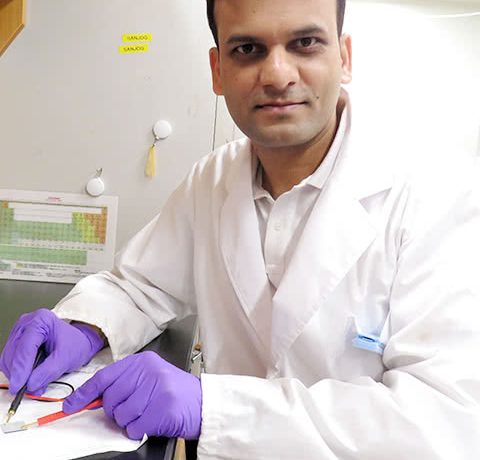AIST Post-Doctoral Fellow, National Institute of Advanced Industrial Science and Technology (AIST)-Kyoto University Chemical Energy Materials Open Innovation Laboratory (ChEM-OIL)*
*JSPS Foreign Research Fellow at iCeMS Kitagawa Lab when paper released
Sanjog S Nagarkar
Sanjog S Nagarkar
Dr. Sanjog S. Nagarkar works on synthesis of melting Coordination Polymers (CPs) and their utilization for clean energy applications. Inspired from natural systems the group successfully developed a Coordination Polymer based glass to harvest solar energy.

Please share with us the significance of your manuscript in terms of its research achievements, impact, or uniqueness.
The biological systems utilize cleaner green routes developed over millions of years to satisfy its energy demands. Creation of photo induced (sun light) proton gradients across membrane is a commonly used path in plants and animals to propel various cellular functions. However, mimicking these biological processes in artificial systems especially in solid state material is a daunting task and need specialized experimental techniques. We have developed a simple route to synthesize defect engineered Coordination Polymer (CP) glass which upon light irradiation generates proton concentration gradient similar to biological system but in the solid state. It is the first demonstration where an asymmetric proton concertation across a CP material is utilized for bio-inspired photo electric current generation. The material can be processed into thin films or fibers to integrate into devices via melt processing.
What would you say is the most exciting or “I made it!” moment during this research project?
Optical control over proton mobility in CP has long been proposed as a future material for a variety of applications. Despite the wide interest, surprisingly there was no success in regards till this work was undertaken. It was at that moment when I was at the edge of my seat and my potentiostat showed increasing potential difference between the electrodes when I irradiated the material with light. Of course I could relax only when I reproduced the results multiple times.
Please tell us about the biggest challenge or problem you experienced while conducting your research. How did you overcome it?

Asymmetric proton concentration is commonly realized by separating the liquid compartments by membranes with asymmetric synthetic nano-channels to avoid mixing. However, the fabrication of these membrane needs expertise and expensive techniques. On the other hand, the solid state material with asymmetric proton concentration is advantageous for wide commercial use as there is no need of additional membrane or leak proof device assembly. Thus, I was encouraged to make use of CP glass for photo electric application. However, the fabrication of CP glass with photo responsive asymmetric concentration was not that easy. One of the main challenge was to incorporate photo responsive molecules in the CP glass in such a way that it can alter the proton concentration and mobility in the CP framework without damaging its overall network connectivity. In most of the trials we were not able to stabilize the glass structure while in other cases there was no change in proton concentration or mobility when irradiated. After many failed attempts and spending lot of time surveying literature we came up with photo acid molecules as a potential candidate. We developed melt functionalization strategy for CP glass to realize bio-inspired photo electric current generation.
Would you consider this work to be a turning point in your overall research direction? If so, how has your research direction changed as a result of this work?
Yes, Development of materials for clean energy applications is an area of intense research for sustainable development. Through my current project I was able get exposure to this fascinating area of research in terms of current trends, technology and synthetic approaches. I am really getting interested in pursuing the clean energy research more seriously and hope to contribute to the development in future as well.
*All the information on this page, including the researcher’s affiliation, is current at the time of the interview.
Paper information
Enhanced and Optically Switchable Proton Conductivity in a Melting Coordination Polymer Crystal
Sanjog S. Nagarkar, Satoshi Horike, Tomoya Itakura, Benjamin Le Ouay, Aude Demessence, Masahiko Tsujimoto, and Susumu Kitagawa.
Angewandte Chemie International Edition
Published: April 2017
DOI: 10.1002/anie.201700962